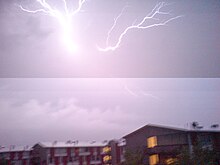Rolling shutter




Rolling shutter is a method of image acquisition in which each frame is recorded not from a snapshot of a single point in time, but rather by scanning across the frame either vertically or horizontally. In other words, not all parts of the image are recorded at exactly the same time, even though the whole frame is displayed at the same time during playback. This produces predictable distortions of fast-moving objects or when the sensor captures rapid flashes of light. This is in contrast with global shutter in which the entire frame is exposed for the same time window.
This method is implemented by rolling (moving) the shutter across the exposable image area instead of exposing the image area all at the same time. The shutter could be either mechanical or electronic.[1][2] The advantage of this method is that the image sensor can continue to gather photons during the acquisition process, thus increasing sensitivity. It is found on many analogue photo cameras - practically all SLRs use a rolling shutter at higher shutter speeds -- as well as digital still and video cameras using CMOS sensors. The effect is most noticeable when imaging extreme conditions of motion or the fast flashing of light. While some CMOS sensors use a global shutter,[3] the majority found in the consumer market utilize a rolling shutter.
CCDs (charge-coupled devices) are alternatives to CMOS sensors. CCDs use what is referred to as global shutters which take a snapshot representing a single point of time and do not suffer from these motion artifacts.[4]
Distortion effects
Rolling shutters can cause such effects as:
- Wobble. This phenomenon (also known as the jello effect) is most common in hand-held shots at telephoto settings, and most extreme in cases when the camera is vibrating, possibly due to being attached to a moving vehicle, for instance. The rolling shutter causes the image to wobble unnaturally and bizarrely.
- Skew. The image bends diagonally in one direction or another as the camera or subject moves from one side to another, exposing different parts of the image at different times. Essentially, skew is a very minor manifestation of the wobble phenomenon described above.
- Smear. This effect can be easily viewed with a cell phone camera and a fan/propeller. The smear of each blade is caused by the propeller rotating at the same or near the same speed that the frame is read by the camera. Viewed perpendicular to a fan spinning clockwise, the blades on the left side appear thinner than usual while the blades on the right side appear thicker and can even appear as if they aren't connected at the center.
- Partial Exposure. If a camera flash goes off in the shot, the quick nature of the flash may only be present for some of the rows of pixels in a given frame. So as an example, the top 1/3 of the picture may be brightly lit by a flash, while the bottom 2/3 of the picture is dark and unlit as the time it took for the flash to occur was only sequenced in a short amount of time as the CMOS imager sequences a frame. The difference between the two distinct parts of the frame can look odd. Similar problems can arise with emergency vehicle lights, some fluorescent lighting, or any extreme situation where very fast motion or very fast bursts of light are seen in the time between when the CMOS chip sequentially records a frame.
- Spatial and temporal aliasing.
The effects of a rolling shutter can prove difficult for visual effects filming. The process of matchmoving establishes perspective in a scene based on a single point in time, however this is difficult with a rolling shutter that provides multiple points in time within the same frame. Final results depend on the readout speed of the sensor and the nature of the scene being filmed; as a rule of thumb, higher end cinema cameras will have faster readout speeds and therefore milder rolling shutter artifacts than low end cameras.
See also
Notes
- ^ "Electronic shuttering: Rolling vs Global shutter" (PDF). Motionvideoproducts. Retrieved 2011-12-22.
- ^ Shutter Operations for CCD and CMOS Image Sensors Kodak
- ^ "Image Sensors - MT9M413C36STC - Aptina Imaging". Aptina.com. 2008-03-03. Retrieved 2010-08-21.
- ^ "To CCD or to CMOS, That is the Question | B&H Photo Video Pro Audio". Bhphotovideo.com. Retrieved 2010-08-21.
